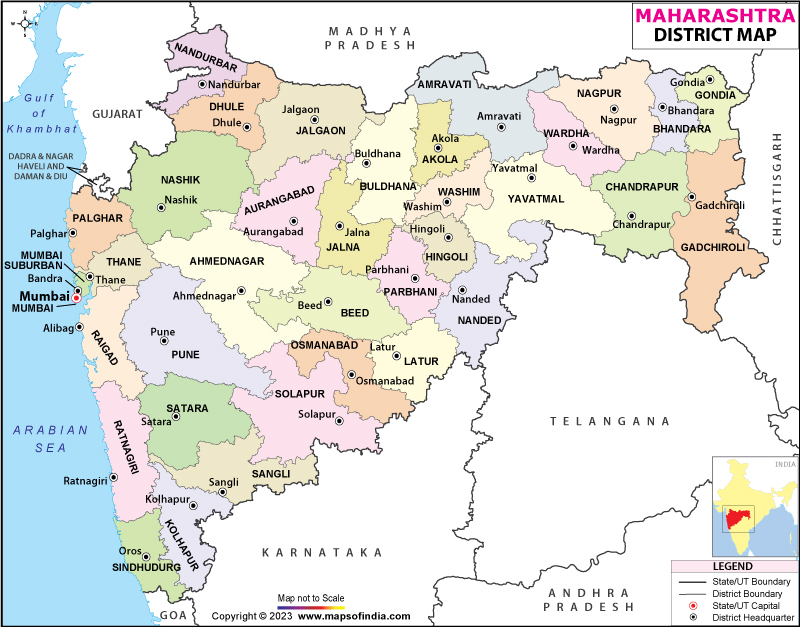KOLHAPUR
| |||||||||
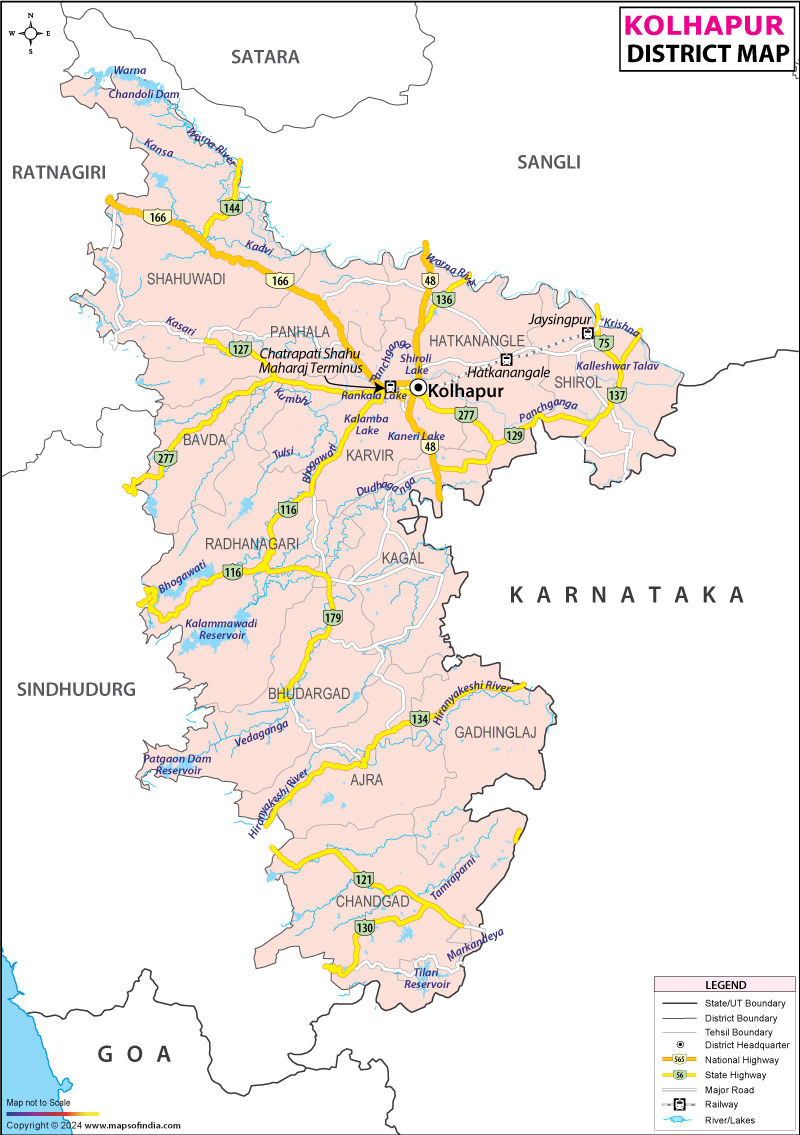 | |||||||||
|
| *Kolhapur District Map highlights the National Highways, Major Roads, District Headquarter, etc in Kolhapur. |
| Major Districts of Maharashtra |
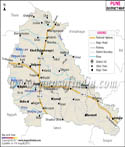 | 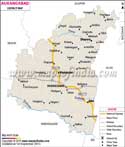 | 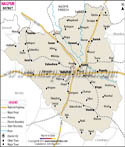 | 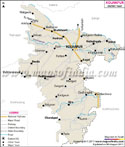 |
| Pune District Map | Aurangabad District Map | Nagpur District Map | Kolhapur District Map |
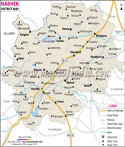 | 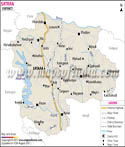 | 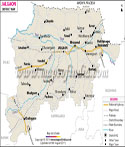 | 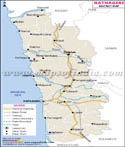 |
| Nashik District Map | Satara District Map | Jalgaon District Map | Ratnagiri District Map |
| other districts of Maharashtra >> | |||
Kolhapur is a land of spectacular monuments and temples. Situated in Maharashtra, it is a major religious base of the state. It is surrounded by Sahyadri mountain ranges.
Apart from this, it is bordered by rivers from all directions. Rich in milk and culture, Kolhapur is rightly called city of palaces and gardens. The headquarters of Kolhapur district is located in Kolhapur city.
Geographic Location of Kolhapur:
Located on the banks of River Panchganga, Kolhapur is situated at a distance of 395 km to the South of Mumbai and 240 km from Pune. The district is located on the Pune - Bangalore National Highway No. 4.
Climatic Conditions of Kolhapur:
The climate in Kolhapur is generally tropical, nevertheless, pleasant. It is basically a combination of coastal and inland climate of Maharashtra. In the summers the temperature ranges from 34° C to 24° C.
Summers in Kolhapur are comparatively cooler but more humid than the summers in the other towns and districts of Maharashtra. Temperature during the winters on the other hand ranges from 27° C to 21° C and climate is less humid. The district receives an average rainfall of 1900 mm. During the rainy season the temperature is fairly low. Heavy rain during this season often results in flood.
History of Kolhapur:
Also known as Dakshin Kashi, Kolhapur was a vital Buddhist base. Kolhapur was once a rich place. However, the earthquakes during the 8th and the 9th century ruined the richness of the town. Rashtrakoot thrived in resettling the town and transformed it into an imopratmt city once in the 12the century.
Kolhapur was invaded by the Mughals. Subsequently, Marathas took over the region. An independent province of Maratha became a part of India in the year 1947. Kolhapur also remained an imperative district during the British rule.
An excavation in 1945 hinted at the association of the district to the Roman Era.
Distance to Kolhapur
Demographics of Ahmednagar:
According to the 2001 census, Kolhapur city population's was 493167.
Time zone:
Kolhapur follows Asia/Kolkata time zone id.
Languages spoken:
Main languages spoken in Kolhapur are Marathi, Hindi and English. Marathi and Hindi are widely used by the major population. English is more common in the urban areas. While Marathi language rules in the other parts of the district.
Economy of Ahmednagar:
Kulhapur is an industrial city. Proximity to the bauxite deposits are of a great advantage to the town. Kolhapur comprises two major industrial areas, Gokulshirgaon and Shiroli which mainly produce aluminum castings, alloys, and bearings.
Kolhapur is a major Indian district that exports milk and milk-products. Jaggery production and Kolhapur chappals have made the district famous world-wide.
Renowned Educational institutes in Kolhapur:
Kolhapur University
Shivaji University
Kolhapur - Engineering Colleges
Geographic Location of Kolhapur:
Located on the banks of River Panchganga, Kolhapur is situated at a distance of 395 km to the South of Mumbai and 240 km from Pune. The district is located on the Pune - Bangalore National Highway No. 4.
Climatic Conditions of Kolhapur:
The climate in Kolhapur is generally tropical, nevertheless, pleasant. It is basically a combination of coastal and inland climate of Maharashtra. In the summers the temperature ranges from 34° C to 24° C.
History of Kolhapur:
Also known as Dakshin Kashi, Kolhapur was a vital Buddhist base. Kolhapur was once a rich place. However, the earthquakes during the 8th and the 9th century ruined the richness of the town. Rashtrakoot thrived in resettling the town and transformed it into an imopratmt city once in the 12the century.
Kolhapur was invaded by the Mughals. Subsequently, Marathas took over the region. An independent province of Maratha became a part of India in the year 1947. Kolhapur also remained an imperative district during the British rule.
An excavation in 1945 hinted at the association of the district to the Roman Era.
Distance to Kolhapur
- From Delhi - 1650 KM
- From Mumbai - 396 KM
- From Ahemdabad - 893 KM
- From Pune - 233 KM
- From Hyderabad - 539 KM
- From Chennai - 933 KM
Demographics of Ahmednagar:
According to the 2001 census, Kolhapur city population's was 493167.
Time zone:
Kolhapur follows Asia/Kolkata time zone id.
Languages spoken:
Main languages spoken in Kolhapur are Marathi, Hindi and English. Marathi and Hindi are widely used by the major population. English is more common in the urban areas. While Marathi language rules in the other parts of the district.
Economy of Ahmednagar:
Kulhapur is an industrial city. Proximity to the bauxite deposits are of a great advantage to the town. Kolhapur comprises two major industrial areas, Gokulshirgaon and Shiroli which mainly produce aluminum castings, alloys, and bearings.
Kolhapur is a major Indian district that exports milk and milk-products. Jaggery production and Kolhapur chappals have made the district famous world-wide.
Renowned Educational institutes in Kolhapur:
Kolhapur University
Shivaji University
Kolhapur - Engineering Colleges
- Government College of Engineering, Kolhapur
- Kolhapur Institute of Technology [KIT], Kolhapur
- D.Y. Patil College of Engineering & Technology (DYPCET), Kolhapur
- Tatyasaheb Kore Institute of Engineering and Technology Warnanagar
- D.K.T.E. Society's Textile and Engineering Institute, Ichalkaranji
- Bharati Vidyapeeth's College of Engineering, Kolhapur
- CPR Government Medical College, Kolhapur
- D.Y.Patil Medical College, Kolhapur
- Krishna Institute of Medical Sciences, Karad [4]
- Yashwant Ayurvedic Medical College,Kodoli
- D.R.K. College of Commerce
- Vivekananda College
- Indumati College
- Hotel Hill Top
- Valley View Grand
- Hotel Panchshil
- Hotel International
- Hotel Ayodhya
- Hotel Vrishali Executive
- Hotel Shalini Palace
- Hotel Rajpurush
- Tourist Hotel
- Hotel Green Land (elegant)
- Dajipur Abhayaryana
- Narasinhawadi
- Mahalaxmi Temple
- New Palace and Chhatrapati Sahu Museum
- Town Hall Museum
- Old Palace
- Rankala Lake Jyotiba Temple
- Maharaja's Palace
- Shahuji Chhatrapati Museum
- Kotiteertha
- Irwin Agricultural Museum
- Vishalgad Fort
- Goddess Tryambuli Temple
- Bhavani Mandap
- Khasbag Maidan
- Rankala Lake
- Gaganbavada
- Gagangiri Maharaj Math
- Shalini Palace
- Radhanagari Dam
- Shivaji Vidyapeeth
- Katyani Devi Temple
- Kashi Vishveshawar Temple
- Holy Khidrapur (Kopeshwar)
- Kaneri Cloister
- Shankaracharya's Cloister

